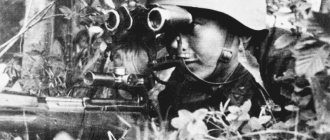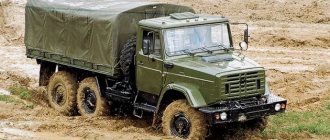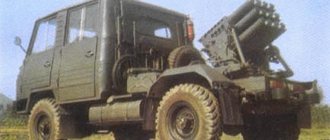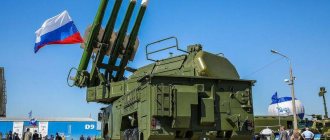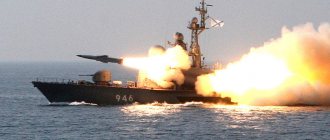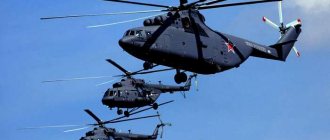The Space Forces of the Russian Federation are a branch of troops of central subordination, designed for timely warning of the highest military-political leadership about a missile attack, control of outer space, missile defense of certain areas, repelling enemy attacks in space and from space, ensuring the activities of the Armed Forces of the Russian Federation in peacetime and war time.
Let's take a closer look at the Russian Space Forces, the history of their creation, the main tasks, what they are equipped with and armed with when they celebrate their professional holiday.
History of creation
- The first space units were formed in 1955 as part of the artillery of the Reserve of the Supreme High Command (RVGK), when by decree of the USSR Government it was decided to build a research site.
- In 1964, to centralize work on the creation of new assets, as well as to quickly resolve issues of using space assets, the Central Directorate of Space Assets (TSUKOS) of the Strategic Missile Forces (Strategic Missile Forces) was created. In 1970, it was reorganized into the Main Directorate of Space Facilities (GUKOS) of the Strategic Missile Forces.
- In 1986, GUKOS was transformed into the Office of the Chief of Space Facilities of the USSR Ministry of Defense.
- In 1992, the Office of the Chief of Space Facilities was transformed into a branch of centrally subordinate forces - the Military Space Forces (VKS).
- In 1997, the Military Space Forces, in order to increase the efficiency of command and control and save the defense budget, were included in the Strategic Missile Forces. In connection with the increasing role of space assets in the system of military and national security of Russia, a presidential decree in 2001 created an independent branch of the force - the Space Forces - on the basis of formations, formations and launch and missile launch units allocated from the Strategic Missile Forces. At the same time, it was taken into account that space forces and means, forces and means of the RKO have a single sphere of problem solving - space, as well as close cooperation of industrial enterprises, ensuring the creation and development of weapons.
- Since December 1, 2011, the Space Forces have been part of the Aerospace Defense Forces.
- On August 1, 2015, they were recreated as a branch of the military as part of the Russian Aerospace Forces.
Space Forces of the Russian Armed Forces: history of creation and tasks. Reference
On October 4, 1957, the launch and control units of spacecraft carried out the launch of the first artificial Earth satellite “PS-1”, and on April 12, 1961, the launch and control of the flight of the world’s first manned spacecraft “Vostok” with cosmonaut Yuri Gagarin on board. Subsequently, all domestic and international space programs were carried out with the direct participation of military units in launching and controlling spacecraft.
In 1964, to centralize work on the creation of new means, as well as to quickly resolve issues of using space means, the Central Directorate of Space Facilities (TSUKOS) of the USSR Ministry of Defense was created. In 1970, TsUKOS was reorganized into the Main Directorate of Space Facilities (GUKOS) of the Ministry of Defense. In 1982, GUKOS and the units subordinate to it were withdrawn from the Strategic Missile Forces (RVSN) and subordinated directly to the Minister of Defense.
In 1992, in accordance with the Decree of the President of the Russian Federation dated July 27, 1992, the Military Space Forces (VKS) of the Ministry of Defense of the Russian Federation were created, which included the Baikonur Cosmodrome, spacecraft launch units at the Plesetsk test site, and the Main Test Center for testing and control of space assets. Colonel General Vladimir Ivanov was appointed the first commander of the Aerospace Forces.
In 1997, according to the Decree of the President of the Russian Federation of July 16, “in accordance with the needs of defense and security, as well as the real economic capabilities of the country,” the Russian Aerospace Forces merged with the Strategic Missile Forces (RVSN) and the Missile and Space Defense Forces (RKO) of the Air Defense Forces.
In 2001, in connection with the increasing role of space assets in the military and national security system of Russia, the country's top political leadership decided to create a new type of military force on the basis of formations, formations and units for launching and controlling spacecraft, as well as RKO troops, allocated from the Strategic Missile Forces. Space Forces. On March 26, 2002, the Minister of Defense of the Russian Federation presented a personal standard to the commander of the Space Forces.
On October 3, 2002, by decree of the President of the Russian Federation, Space Forces Day was introduced, celebrated annually on October 4.
The Russian Space Forces are designed to solve the following tasks:
- detection of the beginning of a missile attack on the Russian Federation and its allies;
- combating enemy ballistic missiles attacking the defended area;
- maintaining the established composition of orbital constellations of military and dual-use spacecraft and ensuring their use for their intended purpose;
- control over outer space;
- ensuring the implementation of the Russian Federal Space Program, international cooperation programs and commercial space programs.
The Space Forces include the Rocket and Space Defense Association (RKO), the State Test Cosmodromes of the Ministry of Defense of the Russian Federation Baikonur, Plesetsk and Svobodny; Main Test Center for Testing and Control of Spacecraft named after G.S. Titov; management for depositing cash settlement services; military educational institutions and support units.
The RKO association includes missile attack warning (MAW), missile defense and space control (SSC) units. It is armed with radar, radio engineering, optical-electronic, and optical means, which are controlled from one center and operate according to a single plan in real time using a single information field.
Management of orbital constellations of spacecraft is carried out by the Main Test Center named after. G.S. Titova. The state test cosmodromes Plesetsk, Svobodny and Baikonur are intended to create, maintain and replenish the domestic orbital constellation of spacecraft.
Space Forces facilities are located throughout Russia and beyond its borders. Abroad, they are deployed in Belarus, Azerbaijan, Kazakhstan, and Tajikistan.
As of the end of 2007, the Russian orbital constellation consisted of 100 spacecraft. Of these, 40 satellites are for defense purposes, 21 are dual-use (capable of simultaneously solving military, socio-economic and scientific problems) and 39 spacecraft for scientific and socio-economic purposes. Since 2004, it has increased one and a half times.
The Space Forces are armed with satellites for specific reconnaissance (optical-electronic and radar reconnaissance), radio-electronic control (radio and radio-technical reconnaissance), communications (Cosmos, Globe and Rainbow series) and a global satellite navigation system for troops ( "Hurricane" series). The launch of satellites into a given orbit is provided by light launch vehicles (Start-1, Kosmos-3M, Cyclone-2, Cyclone-3), medium-sized ones (Soyuz-U, Soyuz-2, "Zenit") and heavy ("Proton-K", "Proton-M") classes.
The main cosmodrome for launching military and dual-use spacecraft is the Plesetsk cosmodrome. It is based on technical and launch complexes for space rockets “Molniya-M”, “Soyuz-U”, “Soyuz-2”, “Cyclone-3”, “Cosmos-3M”, “Rokot”.
The space forces use the means of the ground-based automated spacecraft control complex (NAKU KA): command and measurement systems “Taman-Baza”, “Fazan”, radar “Kama”, quantum-optical system “Sazhen-T”, ground-based receiving and recording station “ Nauka M-04”, radar stations “DON-2N”, “Dnepr”, “Daryal”, “Volga”, radio-optical complex for recognition of space objects “KRONA”, optical-electronic complex “OKNO”.
The structure of the Space Forces includes military educational institutions: Military Space Academy (VKA) named after. A.F. Mozhaisky (St. Petersburg), Pushkin Military Institute of Radio Electronics of the Space Forces named after. Air Marshal E.Ya. Savitsky (Pushkin), Moscow Military Institute of Radio Electronics of the Space Forces (Kubinka), Peter the Great Military Space Cadet Corps (St. Petersburg).
Since July 4, 2008, the commander of the Space Forces has been Major General Oleg Nikolaevich Ostapenko.
The material was prepared based on information from open sources
Main goals
Space forces solve a wide range of tasks, the main of which are:
- monitoring space objects and identifying threats to Russia in space and from space, and, if necessary, countering such threats;
- providing senior management levels with reliable information about the detection of ballistic missile launches and warning about a missile attack;
- launching spacecraft into orbit, controlling military and dual-purpose (military and civil) satellite systems in flight and using individual of them in the interests of providing the troops (forces) of the Russian Federation with the necessary information;
- maintaining the established composition and readiness for use of military and dual-use satellite systems, means of launching and controlling them, and a number of other tasks.
Composition of the space forces
- Space Forces Command;
- Main missile attack warning center;
- Main center for space reconnaissance;
- Directorate for the Introduction of New Systems and Complexes of the Space Forces;
- Missile defense formations;
- Main Test Center named after German Titov;
- State test cosmodrome Plesetsk.
The number of personnel of the Aerospace Defense Forces of the Russian Federation is 165,000 people.
Aerospace Forces weapons
- visual reconnaissance satellites (optical-electronic and radar reconnaissance),
- radio-electronic control (radio and electronic intelligence),
- communications and global satellite navigation system for troops, a total of approximately 100 devices in the orbital grouping,
- The launch of satellites into a given orbit is provided by light (Start 1, Kosmos 3M, Tsiklon 2, Tsiklon 3, Rokot), medium (Soyuz U, Soyuz 2, Molniya M) launch vehicles ") and heavy ("Proton K", "Proton M") classes,
- means of the ground-based automated spacecraft control complex (NAKU KA): command and measurement systems “Taman Baza”, “Fazan”, radar “Kama”, quantum optical system “Sazhen T”, ground-based receiving and recording station “Nauka M 04”,
- detection systems, radar stations "DON 2N", "Daryal", "Volga", "Voronezh M", radio-optical complex for recognition of space objects "KRONA", optical-electronic complex "OKNO".
Moscow missile defense A-135 - missile defense system of the city of Moscow. Designed to “repel a limited nuclear strike on the Russian capital and central industrial region.” Radar "Don-2N" near Moscow, near the village of Sofrino. 68 53Т6 (“Gazelle”) missiles, designed for interception in the atmosphere, are located in five position areas. The command post is the city of Solnechnogorsk.
Space Forces facilities are located throughout Russia and beyond its borders. Abroad, they are deployed in Belarus, Azerbaijan, Kazakhstan, and Tajikistan.
Russian Space Forces: weapons and facilities
March 24, 2011 marked the 10th anniversary of the Russian Space Forces. They were created in accordance with Decree No. 337 of March 24, 2001 of the President of Russia “On ensuring the construction and development of the armed forces of the Russian Federation and improving their structure.” And by the decision of the Security Council of the Russian Federation of February 6, 2001.
Help: Space Forces
- a separate branch of the armed forces of the Russian Federation, responsible for the defense of Russia in space. October 4th is Space Forces Day. The holiday is timed to coincide with the launch of the first artificial Earth satellite, which opened the chronicle of astronautics, including military ones. The first units (institutions) for space purposes were formed in 1955, when by decree of the USSR Government it was decided to build a research site, which later became the world-famous Baikonur Cosmodrome. Until 1981, responsibility for the creation, development and use of space assets was assigned to the Central Directorate of Space Assets (TSUKOS) of the Strategic Missile Forces of the USSR Armed Forces. In 1981, a decision was made to remove the Main Directorate of Space Facilities (GUKOS) from the Strategic Missile Forces and subordinate it directly to the General Staff. In 1986, GUKOS was transformed into the Office of the Chief of Space Facilities (UNKS). In 1992, UNKS was transformed into a branch of troops of central subordination - the Military Space Forces (VKS), which included the Baikonur, Plesetsk, Svobodny cosmodromes (in 1996), as well as the Main Center for Testing and Control of Spacecraft (SC) of the military and civil purpose named after German Titov. In 1997, the VKS became part of the Strategic Missile Forces. Taking into account the increasing role of space assets in the system of military and national security of Russia, the country's top political leadership in 2001 decided to create an independent branch of the military - the Space Forces - on the basis of associations, formations and launch and missile launch units allocated from the Strategic Missile Forces.
The main tasks of the VKS:
— timely warning to the country’s top military-political leadership about the start of a nuclear missile attack;
— creation, deployment and management of orbital constellations of military, dual and socio-economic spacecraft;
— control of the developed near-Earth space, constant reconnaissance of the territories of a potential enemy with the help of satellites;
— missile defense of Moscow, destruction of attacking enemy ballistic missiles.
Troop composition:
— Rocket and space defense,
- State test cosmodromes of the Russian Defense Ministry - Baikonur, Plesetsk, Svobodny,
— Main Test Center for Testing and Control of Spacecraft named after G. S. Titov,
— Department for depositing cash settlement services,
— Military educational institutions and support units.
Number of people: more than 100 thousand people.
Aerospace Forces weapons:
— satellites for specific reconnaissance (optical-electronic and radar reconnaissance),
— radio-electronic control (radio and electronic intelligence),
— communications and a global satellite navigation system for troops, a total of approximately 100 devices in the orbital grouping,
— launching satellites into a given orbit is provided by light (“Start 1”, “Cosmos 3M”, “Cyclone 2”, “Cyclone 3”, “Rokot”) and medium (“Soyuz U”, “Soyuz 2”, “Molniya” launch vehicles) M") and heavy ("Proton K", "Proton M") classes,
— means of the ground-based automated spacecraft control complex (NAKU KA): command and measurement systems “Taman Baza”, “Fazan”, radar “Kama”, quantum optical system “Sazhen T”, ground-based receiving and recording station “Nauka M 04”,
— detection systems, radar stations “DON 2N”, “Daryal”, “Volga”, “Voronezh M”, radio-optical complex for recognition of space objects “KRONA”, optical-electronic complex “OKNO”.
- Moscow missile defense A-135 - missile defense system of the city of Moscow. Designed to “repel a limited nuclear strike on the Russian capital and central industrial region.” Radar "Don-2N" near Moscow, near the village of Sofrino. 68 53Т6 (“Gazelle”) missiles, designed for interception in the atmosphere, are located in five position areas. The command post is the city of Solnechnogorsk.
Space Forces facilities are located throughout Russia and beyond its borders. Abroad, they are deployed in Belarus, Azerbaijan, Kazakhstan, and Tajikistan.
Educational establishments
The training of officers for the space forces is carried out by:
- Military Space Academy named after A.F. Mozhaisky,
- Military Academy of Aerospace Defense named after Marshal of the Soviet Union G.K. Zhukov.
Professional holiday
By order of the USSR Minister of Defense dated August 3, 1960, on the eve of the third anniversary of the launch of the first artificial Earth satellite, October 4 was established as “KIK Day.”
In accordance with Decree of the President of the Russian Federation dated December 10, 1995 No. 1239, October 4 became an official holiday - Strategic Missile Forces Day and Military Space Forces Day.
According to the decree of the President of the Russian Federation of October 3, 2002, October 4 is celebrated as Space Forces Day. The holiday is timed to coincide with the launch of the first artificial Earth satellite, which opened the chronicle of astronautics, including military ones.
Our people in Havana. What did the USSR military do in Cuba?
“The goal of the Soviet military personnel was not to participate in the defense of Liberty Island from foreign invasion, but to train the Cuban army,” retired Major General Mikhail Makaruk, a former military attaché at the USSR Embassy in the Republic of Cuba, told Gazeta.Ru. – Military exercises of various levels were regularly held with Cuban colleagues. The Army of the Republic of Cuba and the National Defense units have become noticeably stronger, including due to our military equipment. Soviet soldiers helped the Cubans during hurricanes and floods; many of our soldiers who are buried on the territory of the El Chico memorial complex near Havana died in 1963, saving civilians from the elements.”
There are “Daggers”, but there are no “Zircons”. What is the Russian army armed with?
On January 20, the Unified Day of Acceptance of Military Products took place. It has been carried out by the Ministry of Defense since 2014...
21 January 19:14
It is officially believed that Soviet troops, military equipment and missiles were transferred to Cuba during Operation Anadyr in July-October 1962. However, back in 1959, after secret negotiations in Mexico between Fidel Castro’s intelligence chief, Major Ramiro Valdez, and the Soviet ambassador, the first Soviet military advisers were sent to Cuba. This was reported by KGB Colonel Oleg Gordievsky, who fled to the West.
“Operation Anadyr is a unique landing operation. Perhaps even a piece. A huge mass of people and equipment was quietly transferred to another part of the planet. And most importantly - rockets. The United States came to its senses when the group was already in Cuba. Yes, then we took out the missiles. But the condition was the withdrawal of US PGM-19 Jupiter missiles from Turkey, for which the operation began. The States removed the missiles and still do not deploy anything similar in Turkey. This is the lesson,” Alexey Begunov, a retired captain of the first rank and former military adviser in Cuba, recalls in a conversation with Gazeta.Ru.
As a result of Operation Anadyr, the 51st Missile Division was transported to Cuba, armed with R-12 and R-14 missile launchers. Within the reach of the former was about a third of the US territory, including Philadelphia, the range of destruction of the latter was greater - they could potentially hit the entire territory of the United States and part of Canada. Covering missiles and technical units was the responsibility of a large ground force.
After the resolution of the Cuban Missile Crisis, missiles with nuclear warheads and some military personnel were removed from Cuba. Some weapons were transferred to the Cuban army. These included more than 100 tanks, air defense and naval equipment. Soviet military advisers were retained to train the Cubans.
The total number of the Soviet military contingent, which included units of missile, ground, aviation and naval forces in 1962, was more than 50 thousand people.
“If Russia invades Ukraine, the Americans will have to pay for it”
Western media and politicians have been regularly talking in recent days about an impending “Russian invasion”...
21 January 16:12
Subsequently, starting in 1963, the planned reduction and withdrawal of Soviet troops began, and about 11 thousand military personnel remained in Cuba. In 1979, it was decided to create a 12th training center on the basis of the group, the existence of which was discontinued in 1993. At the same time, the Cubans themselves were against the cuts.
“The decision to turn the group into a training center was not easy, primarily for political reasons,” recalls General Mikhail Makaruk. – The Cuban side was not initially notified. Official Havana was categorically against it. Our ambassador Vitaly Vorotnikov then had to make a lot of efforts to ultimately obtain the consent of the Cubans.”
Soviet military advisers, among other things, trained Cuban soldiers and officers for operations in Africa. “In 1975, Cuba sent 25 thousand troops to Angola. Before being sent, they all underwent training at our center,” said captain first rank Alexey Begunov.
Almost immediately after the arrival of Soviet troops in Cuba, construction began on the Radio Electronic Center (REC) in Lourdes. It was commissioned in 1967 and operated until 2002.
It was not a separate station, but a permanent formation of the Armed Forces of the USSR, and then the RF Armed Forces, and it was always in a high degree of combat readiness. In addition to the REC itself, which worked for the 6th department of the Main Intelligence Directorate (GRU) of the General Staff of the Ministry of Defense, it also included other communication centers. Thus, the Platon node worked in the interests of the Navy, the Orbit node served the KGB.
“Now technology has changed a lot and improved. But in the 1970s and 80s, close proximity to the United States made it possible to obtain a huge amount of information. It was possible to intercept messages from satellites and, if desired, to interfere. The NASA and US Space Force base at Cape Canaveral was less than a thousand kilometers away. For REC, the base was simply an “open book”; they saw everything that was possible there,” says retired colonel, former military adviser in Cuba Boris Makhankov.
Veterans who served in Cuba note that the military presence on the island gave the Soviet army a unique experience.

